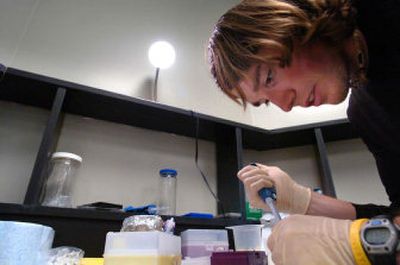Internship is a vocation test lab

Chris Chandler might have spent the summer installing sprinkler systems. Luke Carter could have gone to work as a landscaper.
Instead, the young men are working in the lab at the University of Idaho’s Research Park, and they’re doing more than washing bottles. The students are performing hands-on science in the lab’s efforts to find biological mechanisms that can detect harmful microbes in food – something that’s useful for food safety and preventing bioterrorism.
“They actually have a large part of the project,” said Josh Branen, a research associate who oversees the interns. “Every day they’re working on experiments that are directly applicable to this.”
The internships are in their second year at the Post Falls research facility, and they’re part of a statewide effort in Idaho to encourage students to become involved with science. Similar initiatives are under way around the country, following years of concern about the “science crisis” in education. A National Science Foundation report in 2004 found that while the demand for scientists is rising, the number of American students pursuing careers in science was dropping.
Increasing and supporting undergraduate research, along with the idea that lab research isn’t only for grad students, has been a part of the response by colleges. Washington State and Eastern Washington universities have both emphasized undergraduate research in recent years.
Chandler and Carter are working in the biosensor and nanotechnology lab at the Post Falls research park. Biosensors are essentially methods of using molecules to help screen for food-borne illness, terrorist threats and a huge range of substances. For example, a biosensor might employ an E. coli antibody attached to a microscopic magnet and placed into a milk solution. If E. coli is present, it will bind with the antibody and eventually produce an electric current that can be detected.
Such processes are common in labs, but researchers hope to push the technology into forms that are more portable and easier to use, foreseeing the day that a farmer might use a biosensor to screen the milk in a tank.
But the days of a hand-held biosensor are off in the future, and a large part of the lab’s research is focused on improving all the chemical steps involved in the process. With bioterrorism concerns, the desire to test for dangerous microbes has risen, Branen said.
“We’re looking at a time where you have to screen for everything,” he said. “All sorts of different things could be in that milk.”
Chandler and Carter are closely involved in the work, doing experiments of their own design on various stages of the process.
Chandler, a 20-year-old from Absarokee, Mont., is about to start his junior year at UI studying dietetics and nutrition. On Thursday, he was washing microscopic magnetic beads for use in experiments he would conduct.
His experience in the lab has instilled the desire to do more science.
“I know I want to do some sort of research,” he said. “I’ve learned a ton.”
Luke Carter came to his internship from North Idaho College, which is part of the statewide program intended to create a “pipeline” to science careers in the state, according to UI. The 22-year-old Coeur d’Alene resident is interested in medical fields, but his work this summer has made him interested in pursuing research in particular.
He’s had the chance to set up his own experiments – efforts to measure how antibodies and their antigens bind and react over different lengths of time. Compared to hard labor in the hot sun, he’s found his lab work both fun and interesting.
“The days go by really fast,” he said. “It’s never boring. This week, I can’t believe it’s already Thursday.”